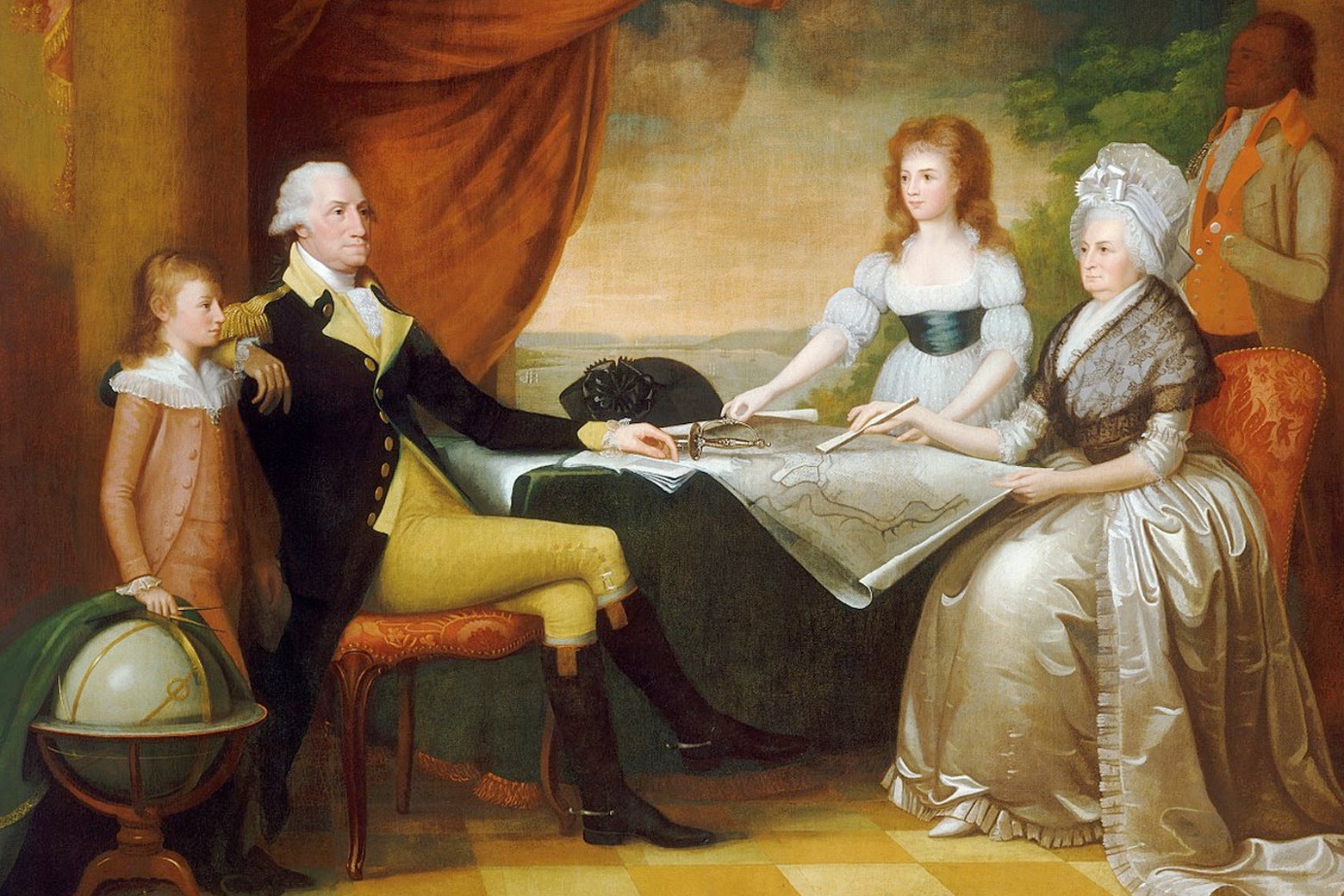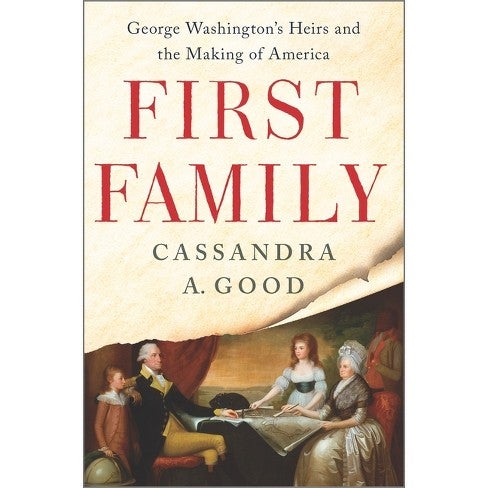This essay is adapted from First Family: George Washington’s Heirs and the Making of America by Cassandra A. Good © 2023 by Cassandra A. Good, used with permission by HarperCollins/Hanover Square Press.
On a cold day in New York City in the winter of 1789, a family prepared to sit for their portrait. This was no ordinary family: It was President George Washington’s. They were America’s very first “first family.” They stood frozen in their poses before the artist in a rented house with luxurious mahogany furniture, rich carpets, and newly painted walls. Through the windows, they could watch white-sailed ships make their way down the East River. In the finished painting, it is the Potomac River that curves gently through the background. In the forefront, George and Martha sit across from each other at a table with a map of the new District of Columbia unfurled. George rests his arm on the shoulder of a young boy in a coral suit standing at his side, while a girl in a white gown stands behind the table and next to Martha. Visible in the shadows of the painting, an enslaved man stands behind the white family. When the portrait was finally completed nearly a decade later, the artist, Edward Savage, reproduced The Washington Family in thousands of prints that made their way into homes across the country.
First Family: George Washington’s Heirs and the Making of America
By Cassandra A. Good. HarperCollins/Hanover Square Press.
Slate receives a commission when you purchase items using the links on this page. Thank you for your support.
In the late 18th and 19th centuries, everyone in the new United States would have recognized these children. But as far as most Americans in the 21st century know, George Washington never had any children. Some may have read the words of George Washington’s most famous eulogist: “AMERICANS! he had no child—BUT YOU,—and HE WAS ALL YOUR OWN.” Who, then, are these children; who was Washington’s family? It was a question I started asking over a decade ago, when I first came across Washington family members in historic records. Clearly, I thought, what I needed was a family tree. As it turned out, this was no simple task.
There were no comprehensive family trees online. With further digging, I located a Washington descendant who had compiled just what I was looking for: a massive family tree that showed all the descendants of George Washington’s father. It arrived in the mail in a tall poster tube, and the document I unfurled stretched 5 feet long and 2 feet wide. The tree mapped out 10 children (by two wives), 40 grandchildren, 130 great-grandchildren, and around 300 great-great-grandchildren. Sprawled out on the floor, I leaned down over the long document to read through the names. The children from the family portrait—whom I had learned were Eleanor (Nelly) and George Washington (Wash) Parke Custis—weren’t there.
The Custis children’s names were absent for good reason: They were not blood-related to George Washington at all. They would appear on a separate family tree only for the Custis family, into which their grandmother (and future first lady) Martha had first married. Martha Dandridge had entered one of Virginia’s wealthiest families when she wed Daniel Parke Custis in 1750. The pair had four children, but only the two youngest, John “Jacky” Parke Custis and Martha “Patsy” Parke Custis, survived past toddlerhood. When Daniel died suddenly in 1757, Martha became the wealthiest widow in the colony—a prime catch for a young man on the make like George Washington.
George and Martha married in 1759, when George was almost 27 and Martha nearly 28. George’s marriage to Martha propelled him into Virginia’s upper gentry. Bringing his wife, her children, some of the 84 enslaved people she inherited, and her wealth to Mount Vernon, George expanded the house (inherited from his brother Lawrence, who died young) and profited off the labor of bondspeople to make his estate productive. Martha maintained her role as the primary parent, with the often-absent George as a stern but loving stepfather to Jacky and Patsy Custis. Jacky was, his stepfather said, “a boy of good genius,” but he was a lazy student whom George lamented was more interested in “Dogs Horses & Guns” than learning. Jacky dropped out of one school after another. His sister Patsy had to stay close to home because she suffered from seizures, which her parents did everything they could to treat. Nonetheless, their “Sweet Innocent girl” (as George called her) died after a fit in 1773 at only 17.
Soon after, Jacky married—against the advice of his stepfather, who felt the 20-year-old Jacky was too immature and irresponsible—a young Maryland woman named Eleanor Calvert. Eleanor and Jacky had seven children, four of whom survived, before Jacky died suddenly in 1781. Elizabeth (Eliza), Martha (Patty), Nelly, and Wash Parke Custis, then, were, in today’s parlance, George Washington’s stepgrandchildren. While Americans in the 18th and early 19th centuries did not use the language of “stepfamilies,” such blended families were quite common due to high death and remarriage rates.
With four children aged 5 or under on her hands, Eleanor Calvert Custis might well have been overwhelmed. Martha, missing having children in the house, offered to take Nelly and Wash and raise them at Mount Vernon with George. This would not have been unusual at the time, and Eleanor and her elder daughters lived close by and visited regularly. There was as of yet no legal form of adoption, but people referred to Nelly and Wash as George’s “adopted” children. Nonetheless, this was also a time when blood relationships were central to legal definitions of family and inheritance. Thus George Washington could essentially adopt two children and raise them as his own, but “have” no children.
Indeed, while never having any biological children of their own, George and Martha raised and supported other children beyond the Custis grandchildren. They took in a bevy of nieces and nephews over the course of their decades together. Both George and Martha had numerous siblings and, in George’s case, half siblings. A rotating cast of orphaned nieces and nephews, or those whose parents had too many children at home to support, made temporary homes with the Washingtons. Others received considerable financial support and advice. It was Bushrod Washington, the eldest son of George’s late eldest full brother, who inherited the famous Washington estate of Mount Vernon.
Is Edward Savage’s family portrait really the Washington family, then? It turned out that the answer to my question—who was George Washington’s family?—was far more complicated than I imagined. Over more than a decade, I have searched through images, objects, houses, financial records, letters, and diaries scattered over museums and archives from Boston to New Orleans. I read 19th-century newspaper and magazine articles, spoke to living descendants, and conferred with archivists and fellow historians. I spent months researching at Mount Vernon, working through papers in its library vault and talking with curators and librarians there. As the pieces fell into place, I found that there was no single definition of George Washington’s family or who counted as his descendants. But one thing was clear: For Americans from the Revolution to the Civil War, the Custis grandchildren were George Washington’s family.
This was no accident: It was the result of choices that George, Martha, the Custises, and the Washington nieces and nephews all made. While George supported many of his nephews and nieces, his closest emotional bonds were with Martha’s grandchildren. They, especially Nelly and Wash, spent the most time living with him, hearing his stories, and experiencing life as the nation’s first “first family.” Martha prioritized keeping the family together, bringing the children with them as the capital city moved from New York to Philadelphia. The public visibility all four siblings gained during the presidency cemented their role as George’s family early on in their lives. None of George’s blood-related family members ever had this kind of close access and public recognition.
After George Washington’s death, the Custises and the Washington nieces and nephews continued on diverging paths. While a Washington nephew inherited Mount Vernon, the house was an empty shell when he moved in; all the Washington furniture, china, clothing, and other household objects that quickly attained the status of relics ended up in the Custis grandchildren’s hands. The grandchildren, then, had both the family stories and belongings that could keep George’s memory and legacy alive. They chose to use those strategically at every step, while the Washington nieces and nephews lived largely in obscurity as small Virginia planters. When Bushrod Washington, inheritor of Mount Vernon, died in 1829, his obituary did not even mention his relationship to his famous uncle. His nephew and grandnephew who next owned Mount Vernon, John Augustine Washington II and III, similarly preferred to stay out of the limelight.
It was the Custis grandchildren, then, who took center stage as George Washington’s family. They nurtured their celebrity as the first family, contributing to political discussions, inviting visitors to their homes to share stories and display relics, and serving as representatives of George Washington’s Revolutionary legacy at social and political events. None of them had any particular talents or accomplishments in their own right; their fame came from who they were and how they shaped their public personas, not what they had done.
Perhaps we should not be surprised, then, that the Custises were largely forgotten within a few decades of their deaths in the mid-19th century. They had never been George Washington’s blood relatives; it had been through their own choices and efforts that the nation had known them, rather than the many Washington nieces and nephews, as the first president’s family. Americans defaulted to a definition of family that they still rely upon today: Family was about blood relationships.
That didn’t mean that the American public lost interest in Washington’s family; to this day, they are interested in presidential descendants. But to be a descendant means being a blood descendant, even if your ancestors had little or no personal relationship with the president. In 2008, genealogy company Ancestry.com’s chief family historian tracked down the closest male heir to George Washington to answer a question that would have appalled George himself: Who would be king if the first president had become a monarch? This wasn’t the first person to go on such a quest; periodicals in 1908, 1951, and 2000 had done the same. The winner this time: Paul Emery Washington, a Texas businessman whose own 2014 obituary noted that he “was the closest descendent of President George Washington.” Today, this man’s descendants would be able to join the newly formed Society of Presidential Descendants—you can join as direct or collateral descendants, the latter only if you are “related by bloodline (lineage of the president’s parents (father and mother)”—but the descendants of the Custis grandchildren could not.

